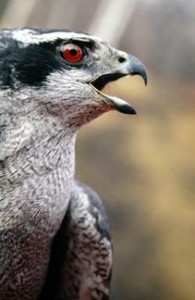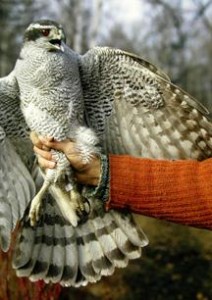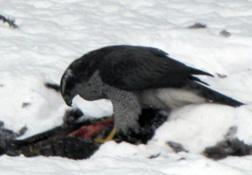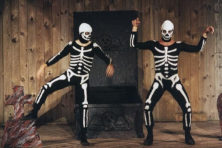The Northern Goshawk
- Share
- Tweet
- Pin
- Share

Deep red irises indicate an adult Goshawk. Young Goshawks have dull yellow irises. Photo by Roy Lukes.
Few wild birds seen in Door County during the past 46 years have left me with a deeper sense of awe and respect than the Northern Goshawk.
My most favorite and fitting description of this bird was written by Herbert Ravenel Sass in 1930 for the Life Histories of North American Birds of Prey by Arthur Cleveland Bent: “…the largest and strongest in the accipiter clan, the Northern Goshawk, is one of the deadliest, handsomest, bravest of the birds of prey of the world – with brilliant eyes through which the fierce spirit of this fiery-hearted warrior gleams at times like points of living flame – the Northern Goshawk ranks second to none in martial beauty and in fearlessness.”
The reason the Goshawk is on my mind today is that Charlotte and I went to visit friends living in southern Door County several days ago to see the remains of the largest prey animal I could imagine, a wild turkey, which had been killed by a Goshawk! The most common prey animals of this swift hawk in our region are Red Squirrels, Crows, Blackbirds and Grackles. A few days earlier our friend had looked out of his garage window, facing north toward the edge of a Northern Cedar swamp, to see some struggling going on between two large creatures. It turned out that the Turkey was still alive as the Goshawk, clinging to the back of the Turkey, wings spread outward and flailing, was beginning to tear back feathers off of its victim. Soon it was striping meat from along the Turkey’s spine as the struggle gradually subsided.
Early the next day the Goshawk returned to the dead Turkey to continue securing another meal. It wasn’t long before a Red Fox and a Coyote, along with a number of small rodents and Blue Jays, had removed virtually every ounce of meat from what little remained on the bones. Feathers were scattered in all directions.
It’s been very exciting from year to year having new sightings and experiences with the Goshawk, providing us with an upward spiraling growth of our understanding and appreciation of this truly wild and seldom seen accipiter (ak-SIP-i-ter). My very best teacher about birds of prey has been Tom Erdman, curator of the Carl Richter Natural History Collection at UW – Green Bay for many years. I got Tom started in bird banding in 1966 with a sub-permit under my master’s license shortly after he had graduated from East High School in Green Bay. Eventually he got his own master’s license and has excelled especially in the banding and study of predatory birds, notably Northern Goshawks and Saw Whet Owls.
In early June of 1987 Charlotte and I spent several hours watching Tom capture some adult and nestling Goshawks for banding and scientific study. It was the kind of in-depth learning experience that resulted in our developing a much deeper respect and admiration for not only the magnificent Goshawks but also for Tom, who has so unselfishly spent many hundreds of hours, with his own funding, studying these hawks and other birds. A close friend of Tom’s, a famous bird artist from Wisconsin, Jonathon Wilde, was helping Tom with the banding.

This banded Northern goshawk shows its fierce temperament while being held by Tom Erdman. Photo by Roy Lukes.
Friends of ours had previously discovered the nests accidentally. Ear-piercing screams and “dive bomber” attacks by the hawks easily identified the birds. Their nesting sites were marked, and Tom determined the day of banding the young from past experience with other Goshawks in the general region.
A permanently injured Great-horned Owl, incapable of flight and continuously protected against injury from the hawks, was used to lure the live Goshawks into a nylon mist net one at a time for capture. The fearless ferocity of the adults, attacking the bird bander at the nest, makes it necessary to capture the adults first and hold them in containment while the young are being banded.
The period between egg hatching and fledging is approximately 42 – 43 days based upon many nests that Tom has studied. All the while the larger female is incubating the eggs and caring for the young, the smaller male is out hunting game. The wing size of the male is larger in proportion to total body weight than on the female. He needs to be a more efficient flier because he does most of the food finding for both the female and the nestlings until the young are large enough to fend for themselves. Each nest contained fresh Hemlock twigs and needles in the lining.
Many measurements were recorded for both adults and chicks in addition to their being banded. Wing and tail feathers were measured, a record of feather molt was taken, eye color determined, pelage checked for parasites, and the birds were weighed. A small feather was collected from each bird for future chemical analysis.
Tom strapped pole grippers onto his legs and proceeded to climb to the nests, which were about 35 feet above the ground in Paper Birch trees. The young in the second nest were estimated to be 35 – 40 days old. They were considerably feathered out, and one hopped onto a nearby branch and had to be carefully coaxed with a twig back to the nest. Two of three in this nest were females and displayed their well-developed vocal power by occasionally screaming to the tops of their lungs.
At the time, one male Goshawk that Tom was studying elsewhere was 14 years old, had had four different mates through the years and produced around 30 young to date. The male was an exceptionally strong bird. Female Goshawks may mate in their second year while the males will not mate until their third year or later.

Note the white eye line and hooked beak on the goshawk as it starts to feed on the Wild Turkey. Contributed.
Following the banding and study of the young in their nest, Tom released the adults while the rest of us marveled at their ability, using their short powerful wings and their long tails as rudders for steering, to fly easily and swiftly through the woods. Tom assured us that they would quickly return to the nest as soon as we left and probably not even realize that their babies had been handled and banded.
The exhilarating Goshawk study experience left us with a much deeper admiration for these creatures of the wild and a realization of their constant need for large undisturbed woods. Hopefully these birds of prey will find good nesting conditions here for many years to come. The wildness they need for living also appeals greatly to us and many of our friends.
As I’ve often mentioned in the past, and will continue to stress, let’s KEEP DOOR COUNTY WILD!




